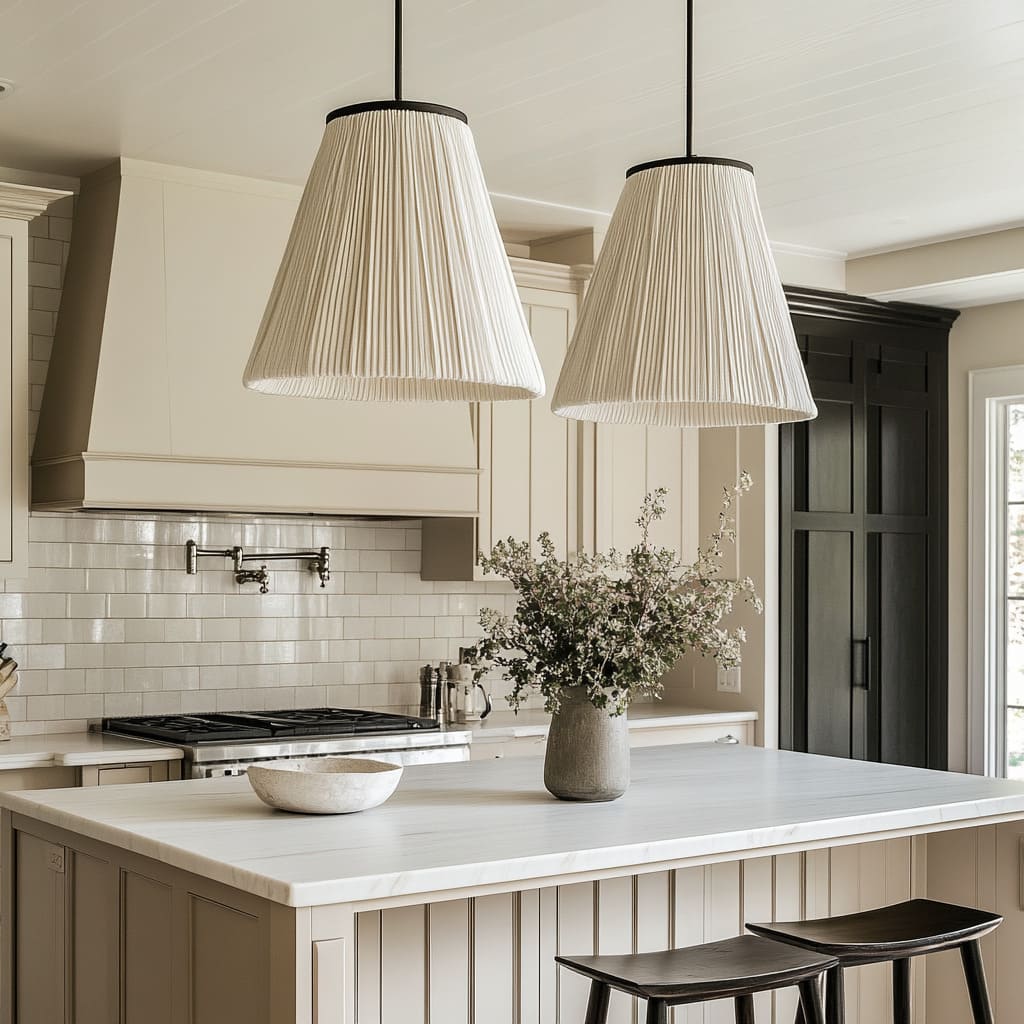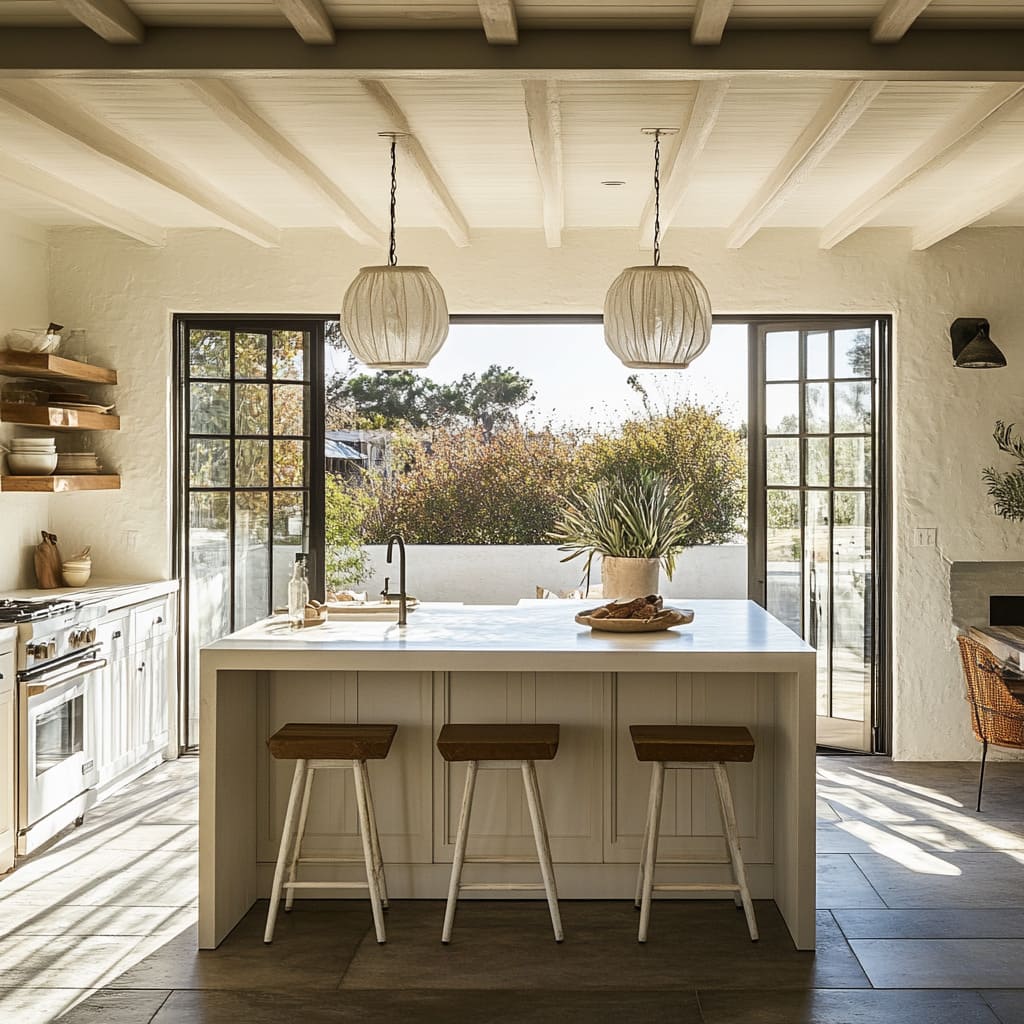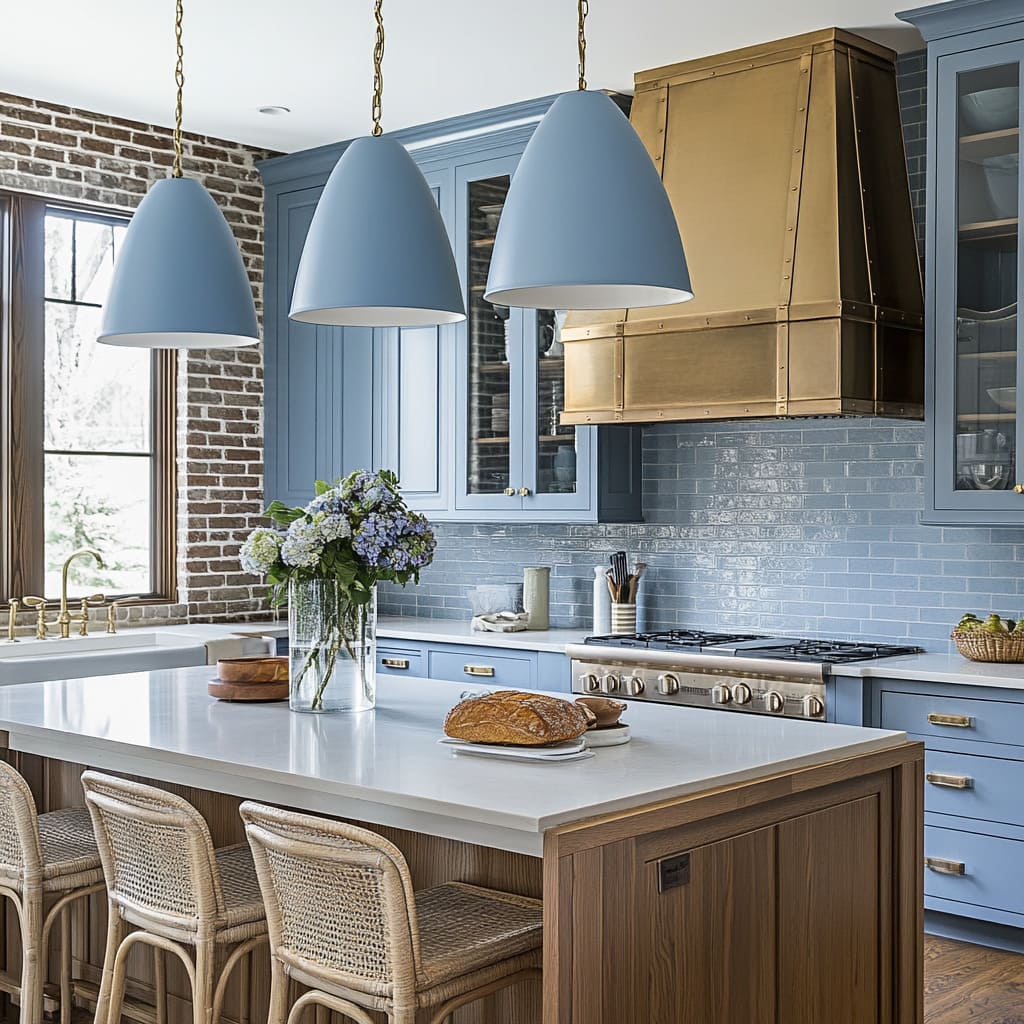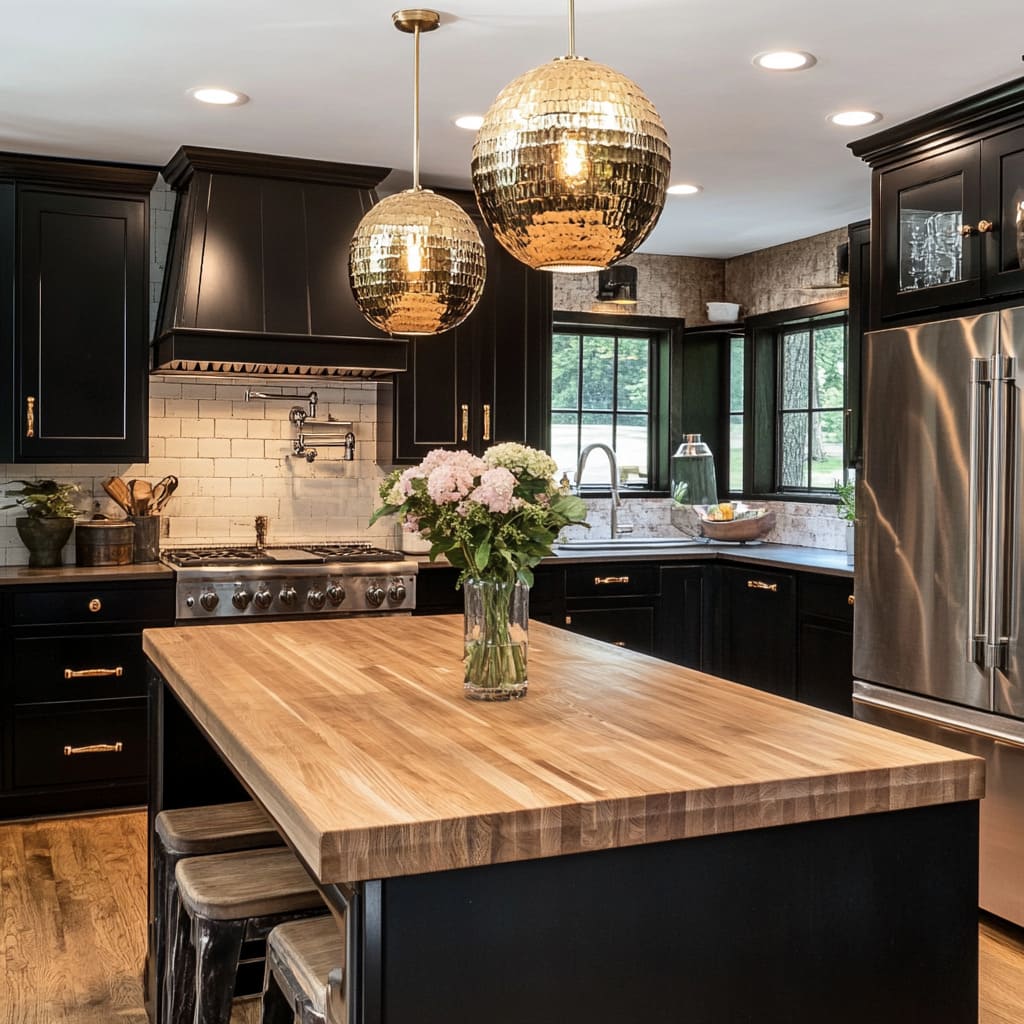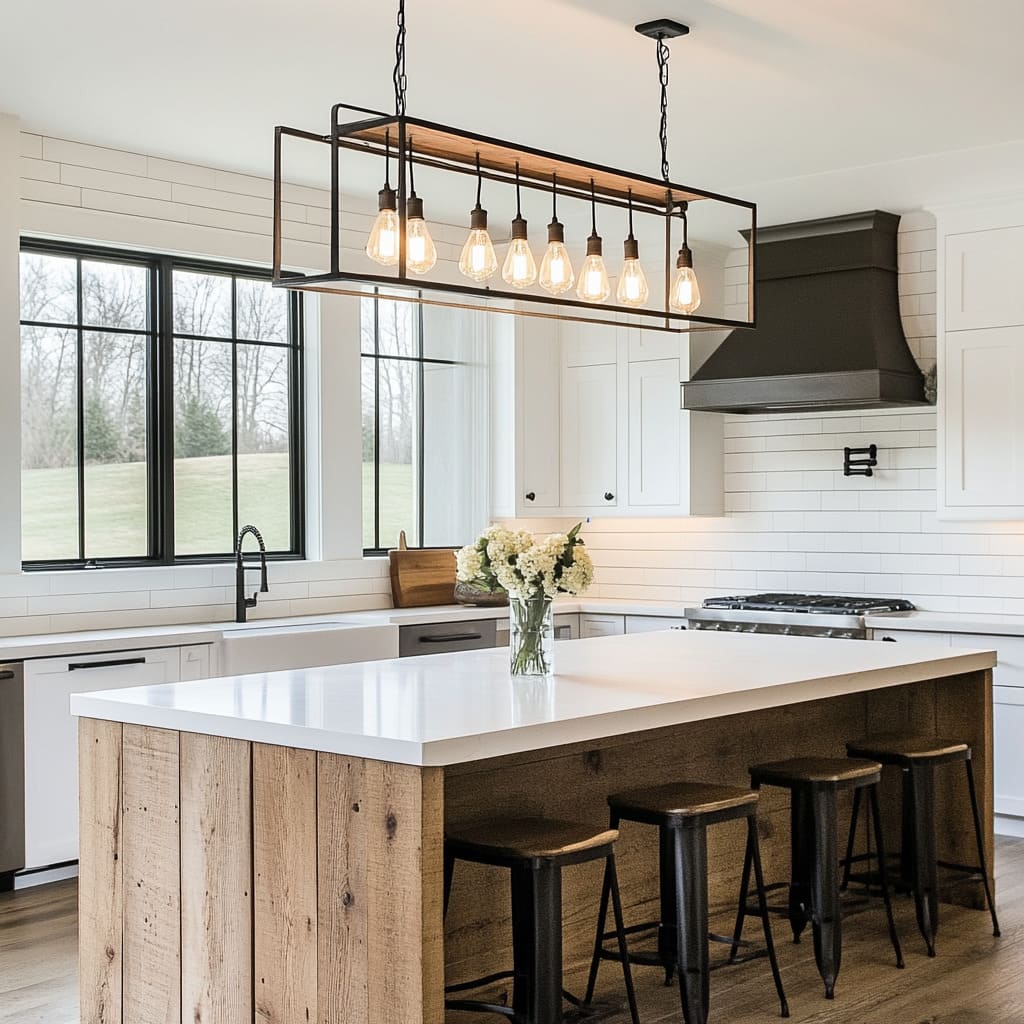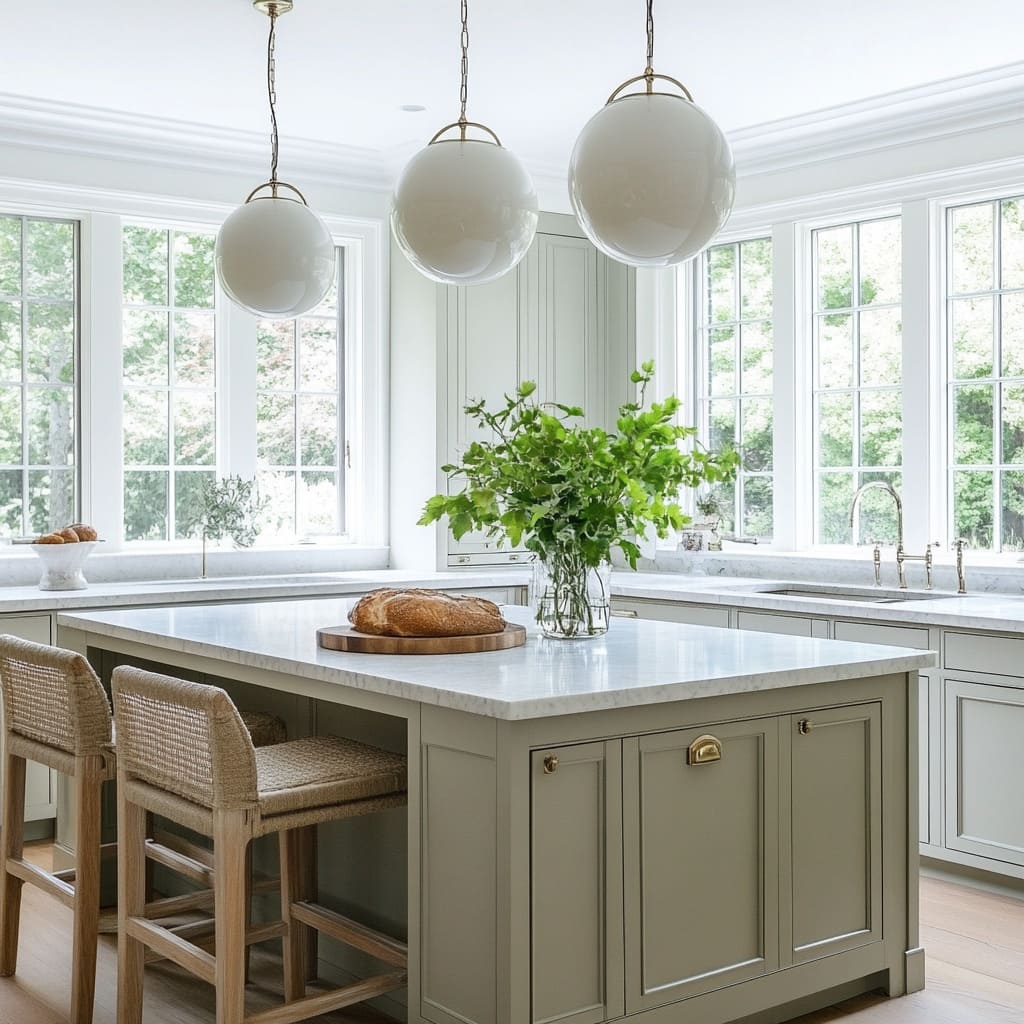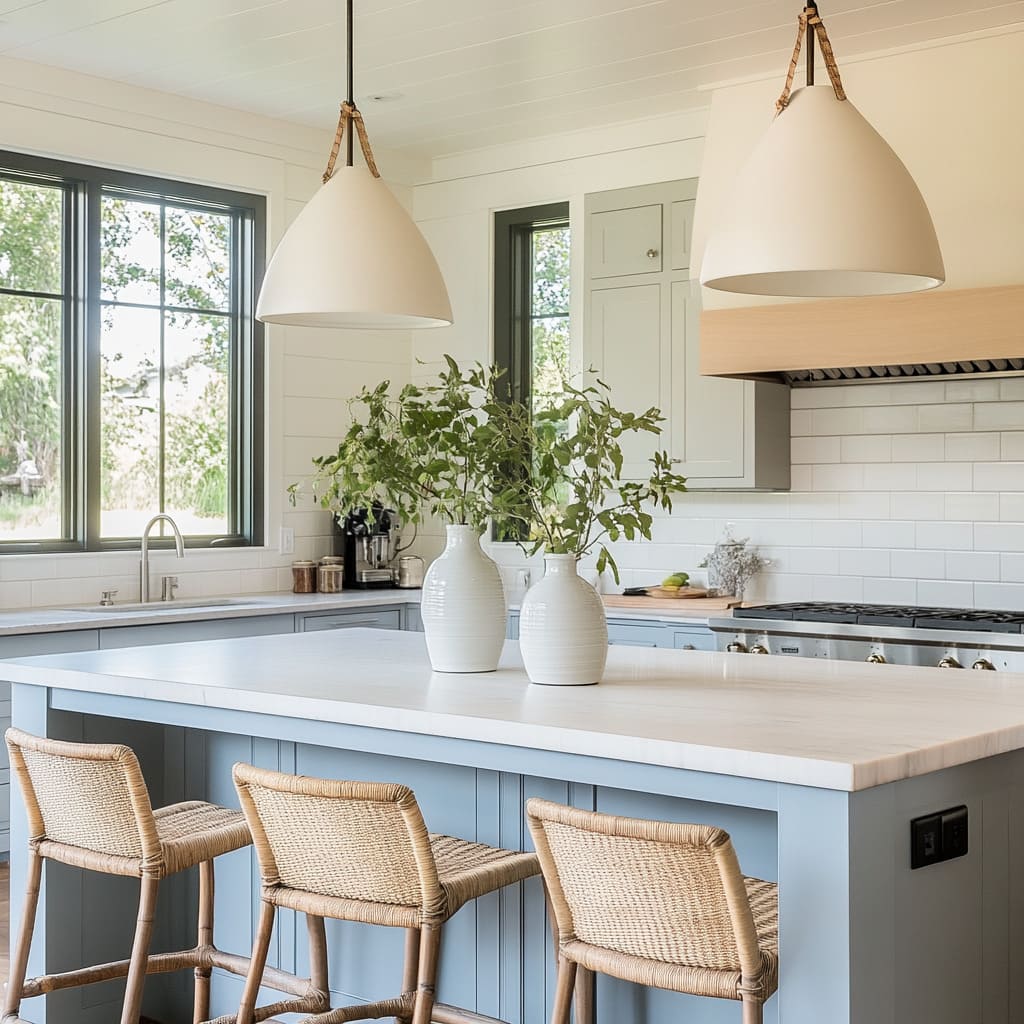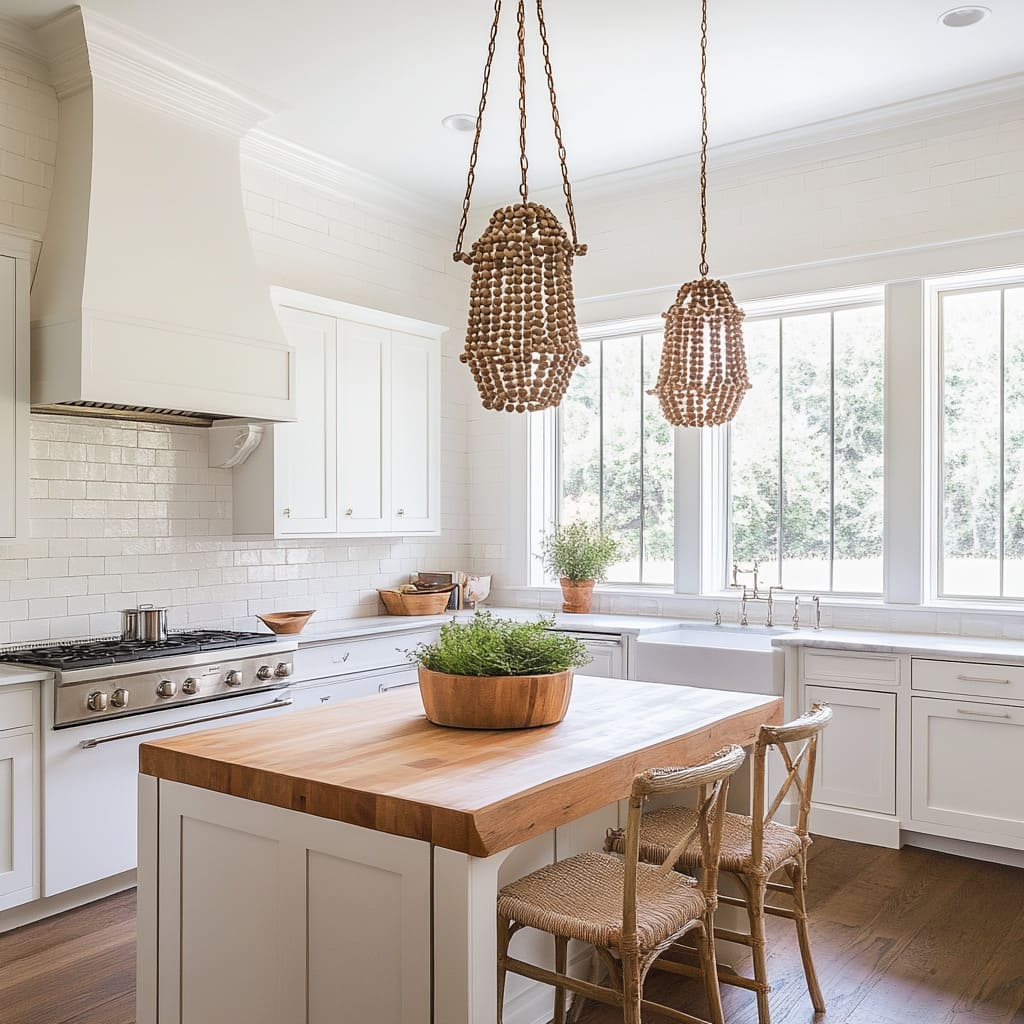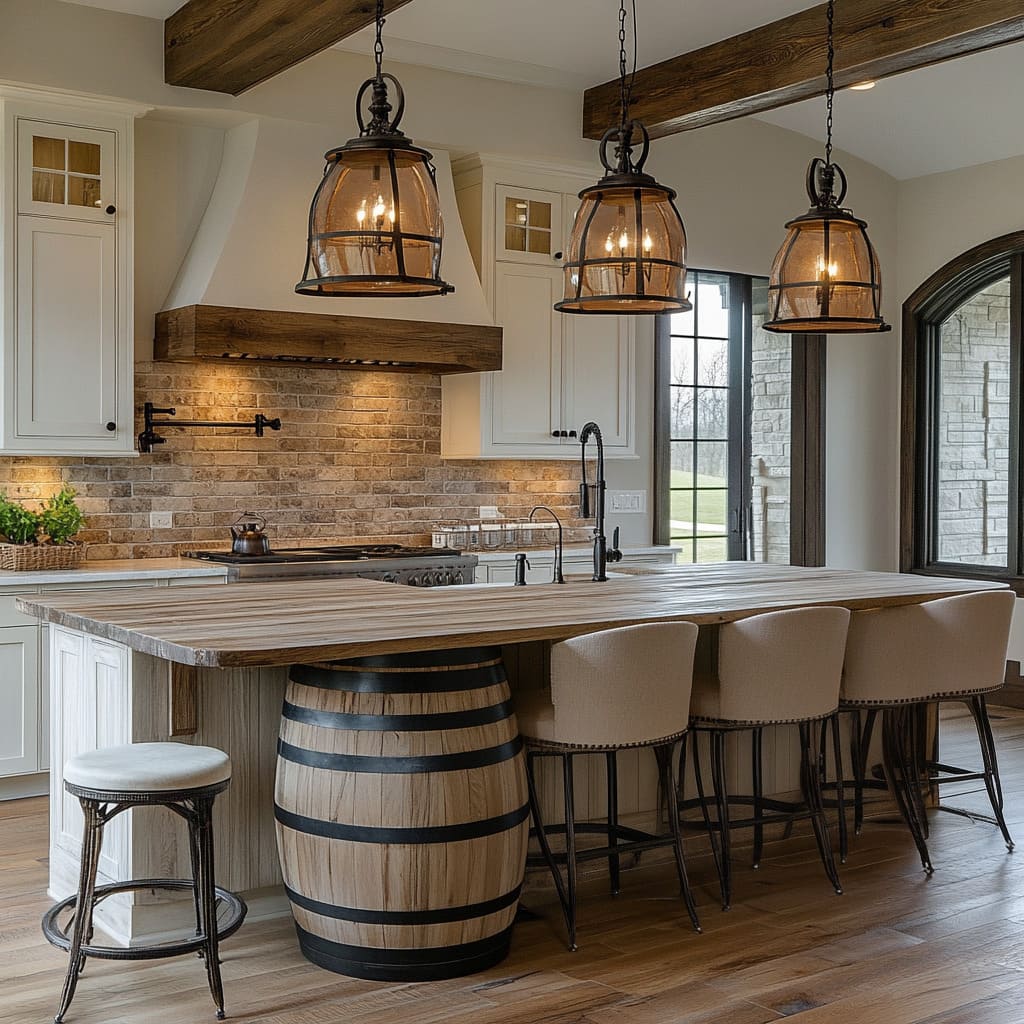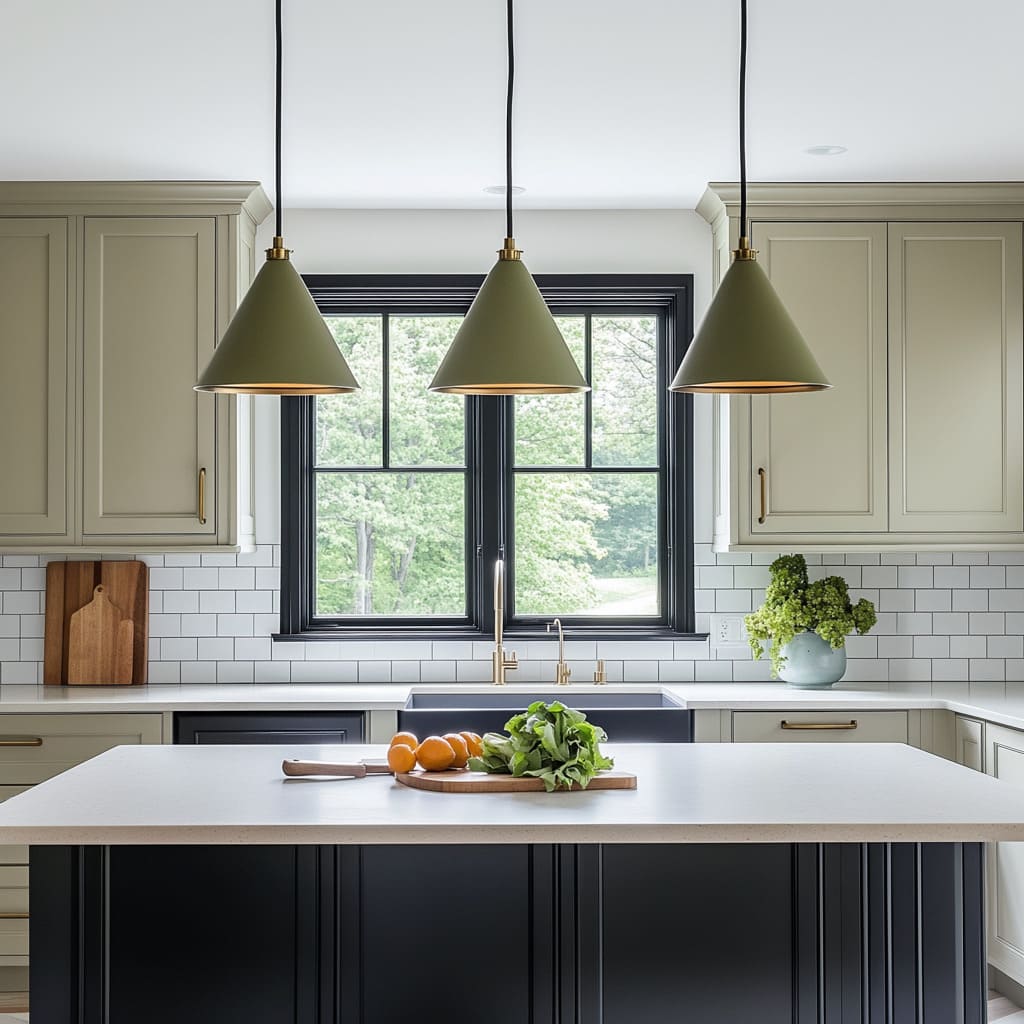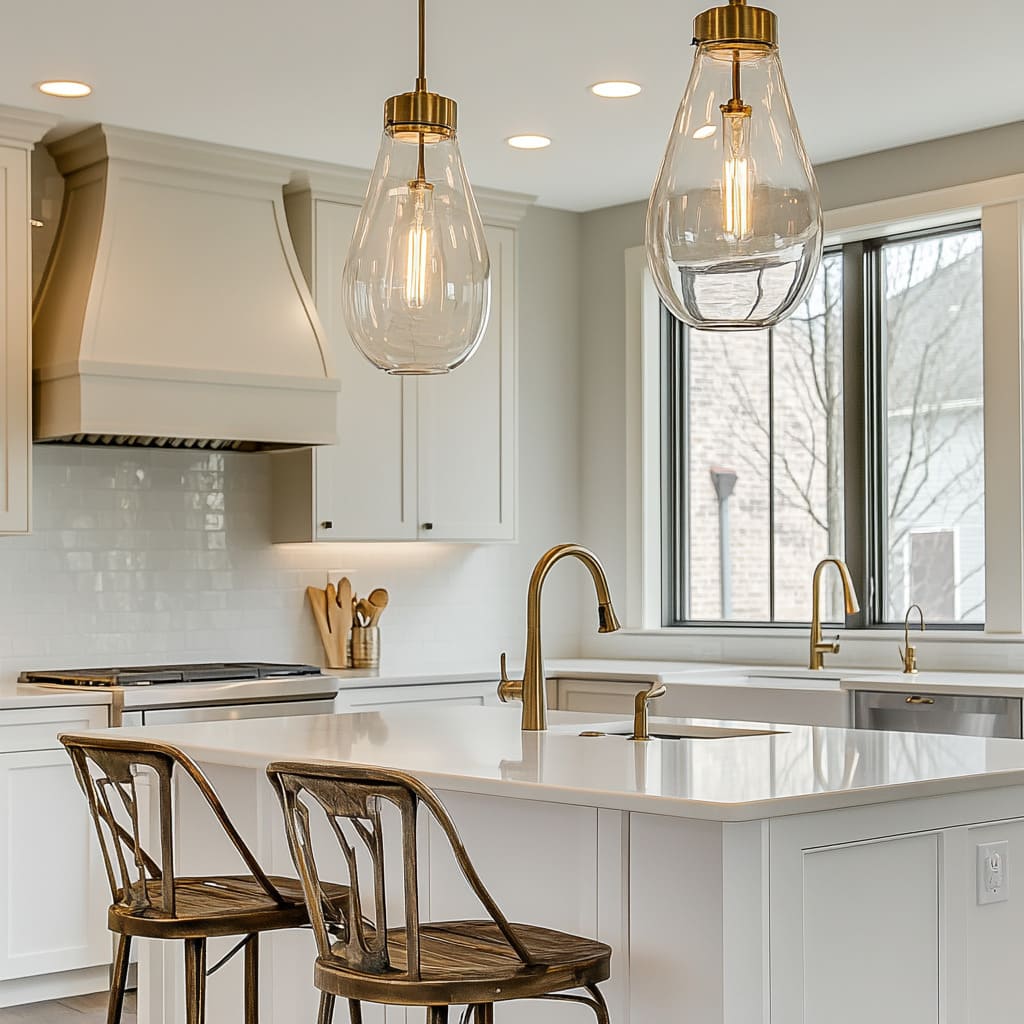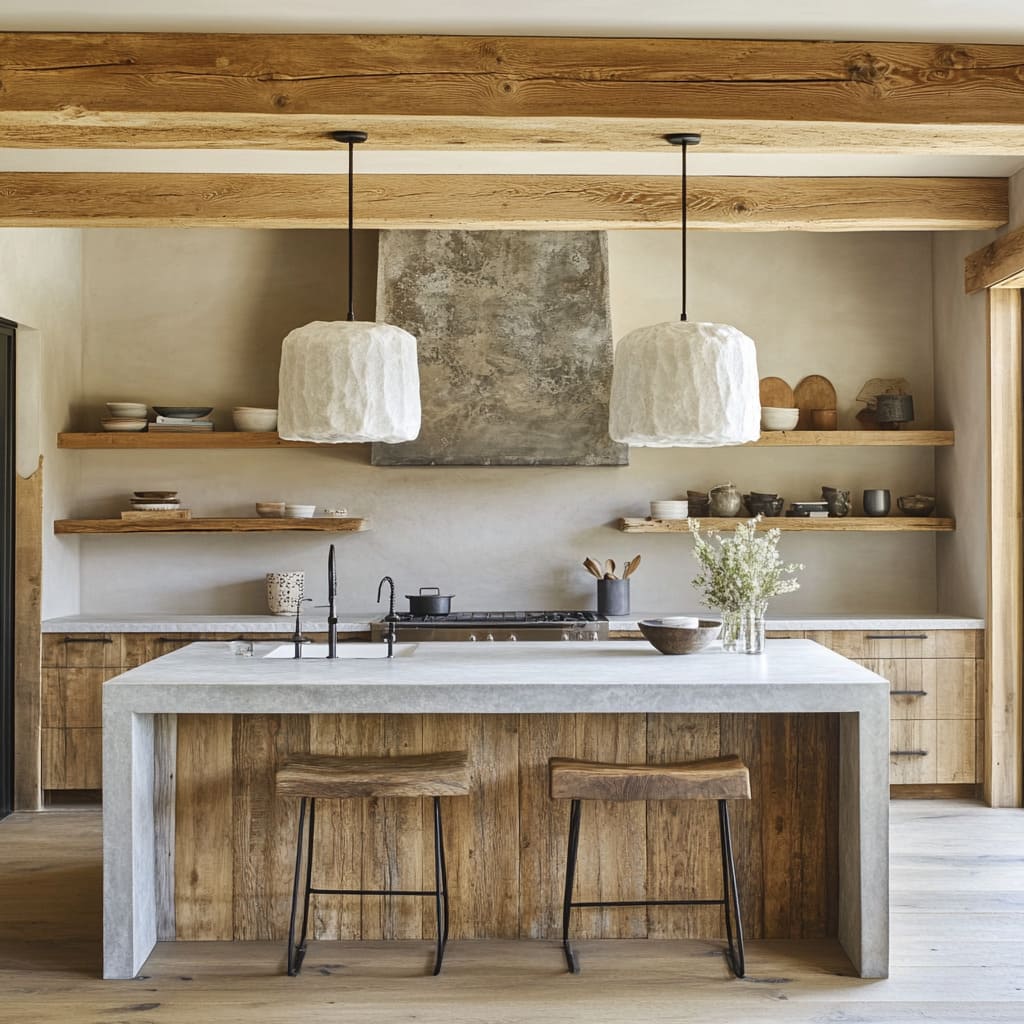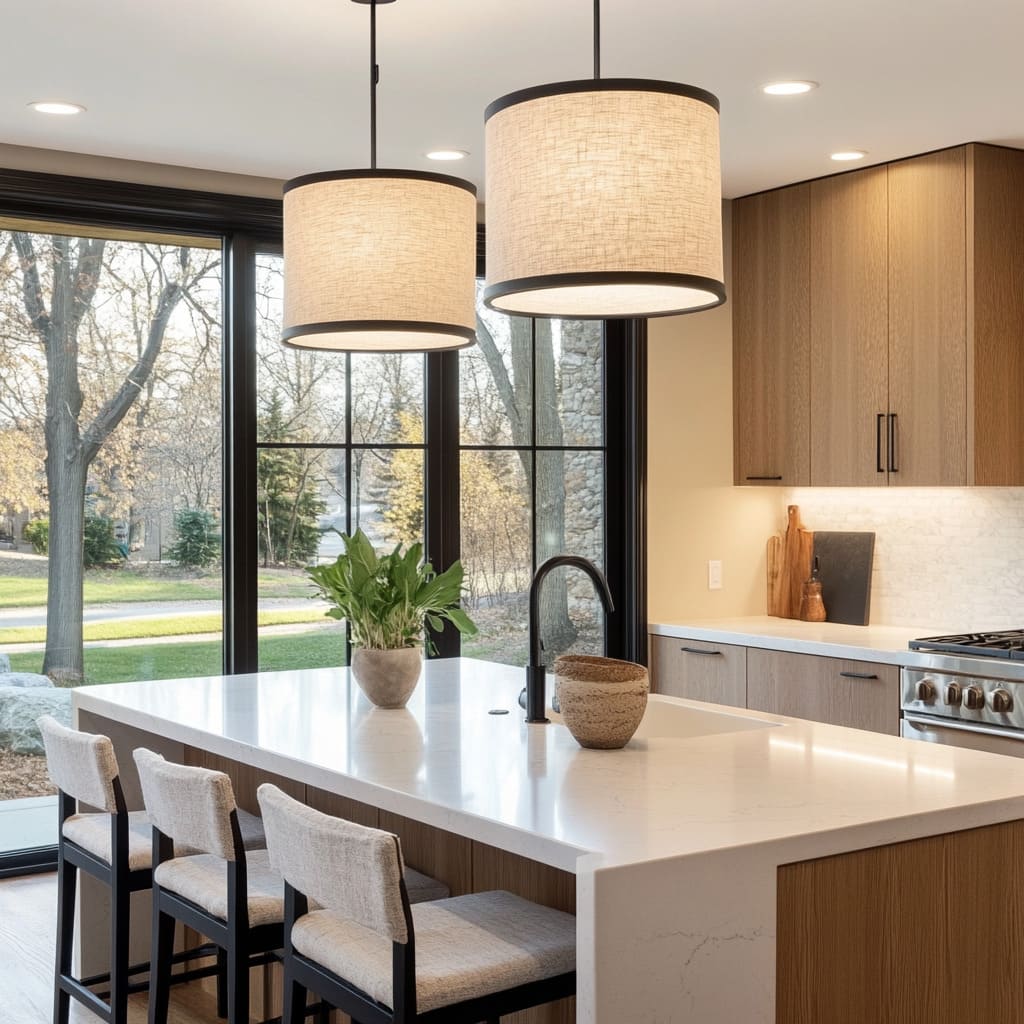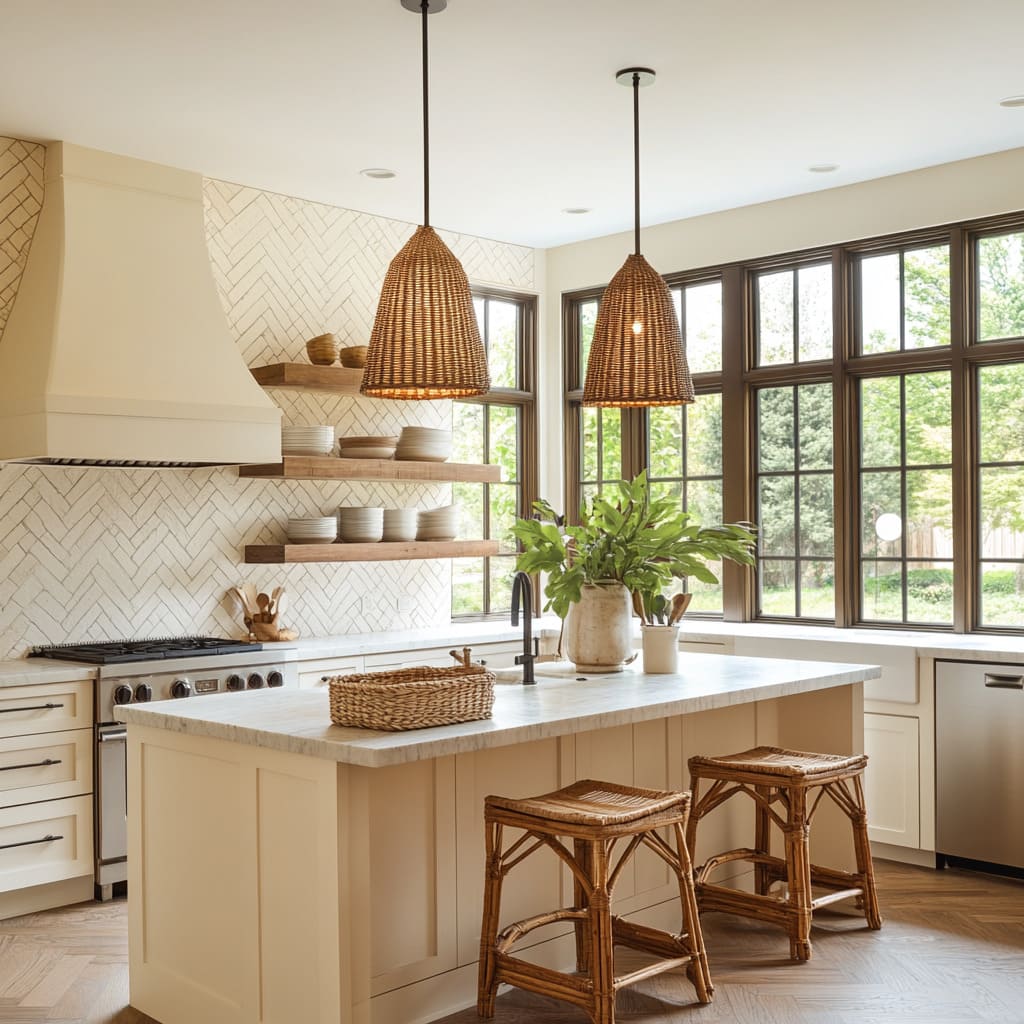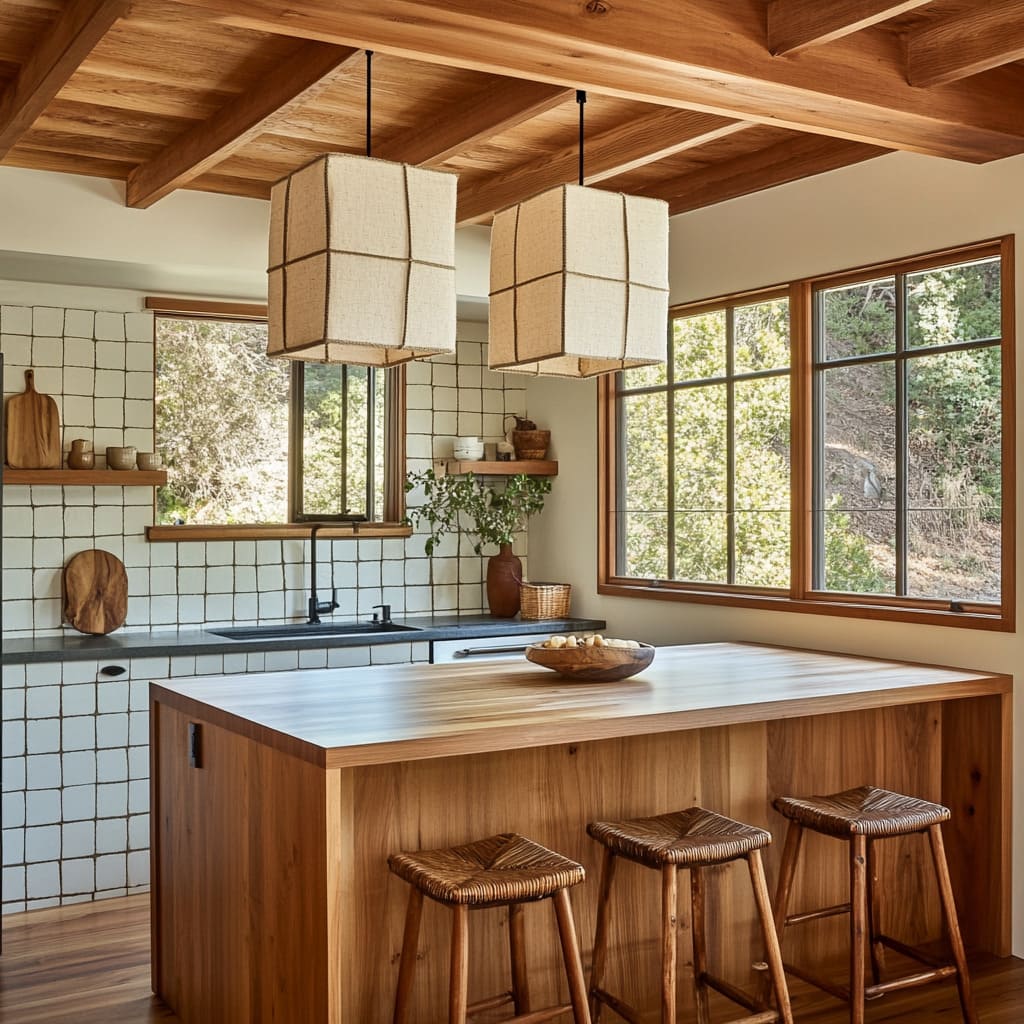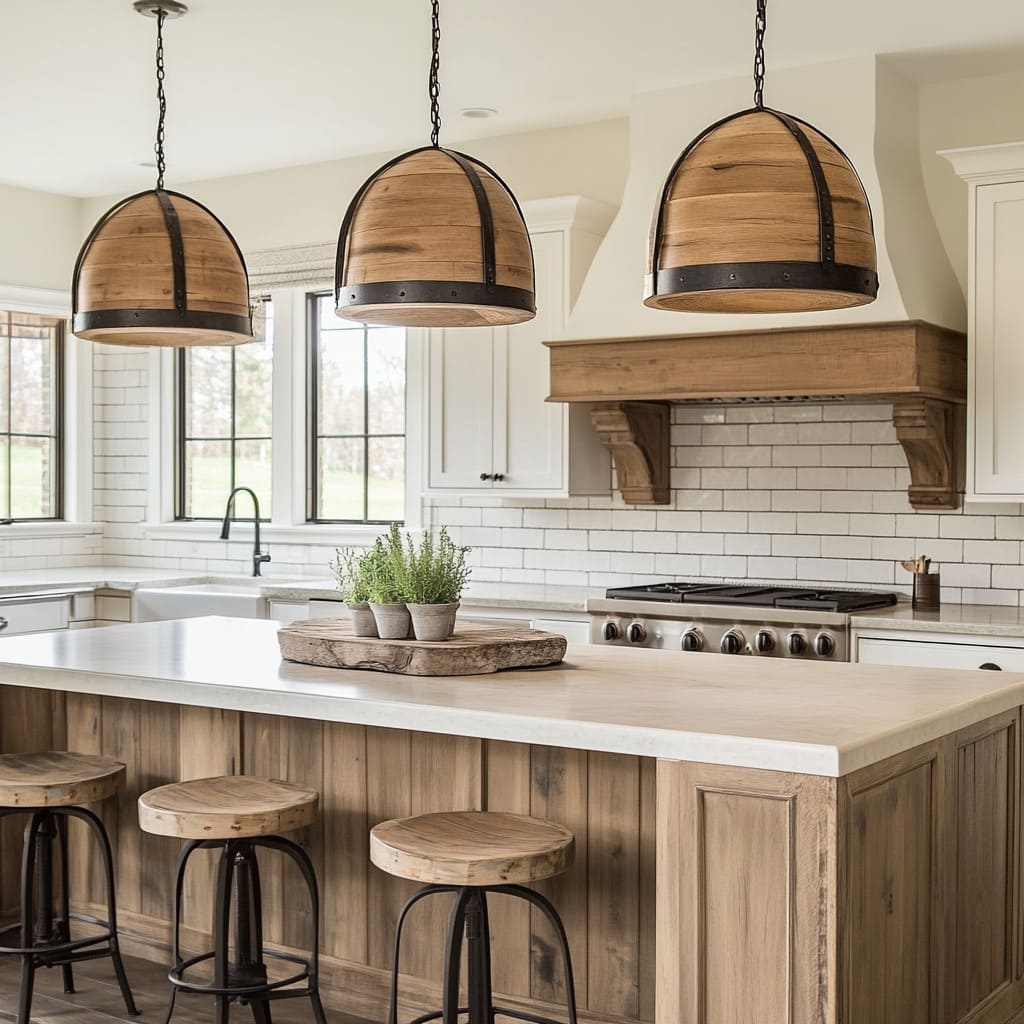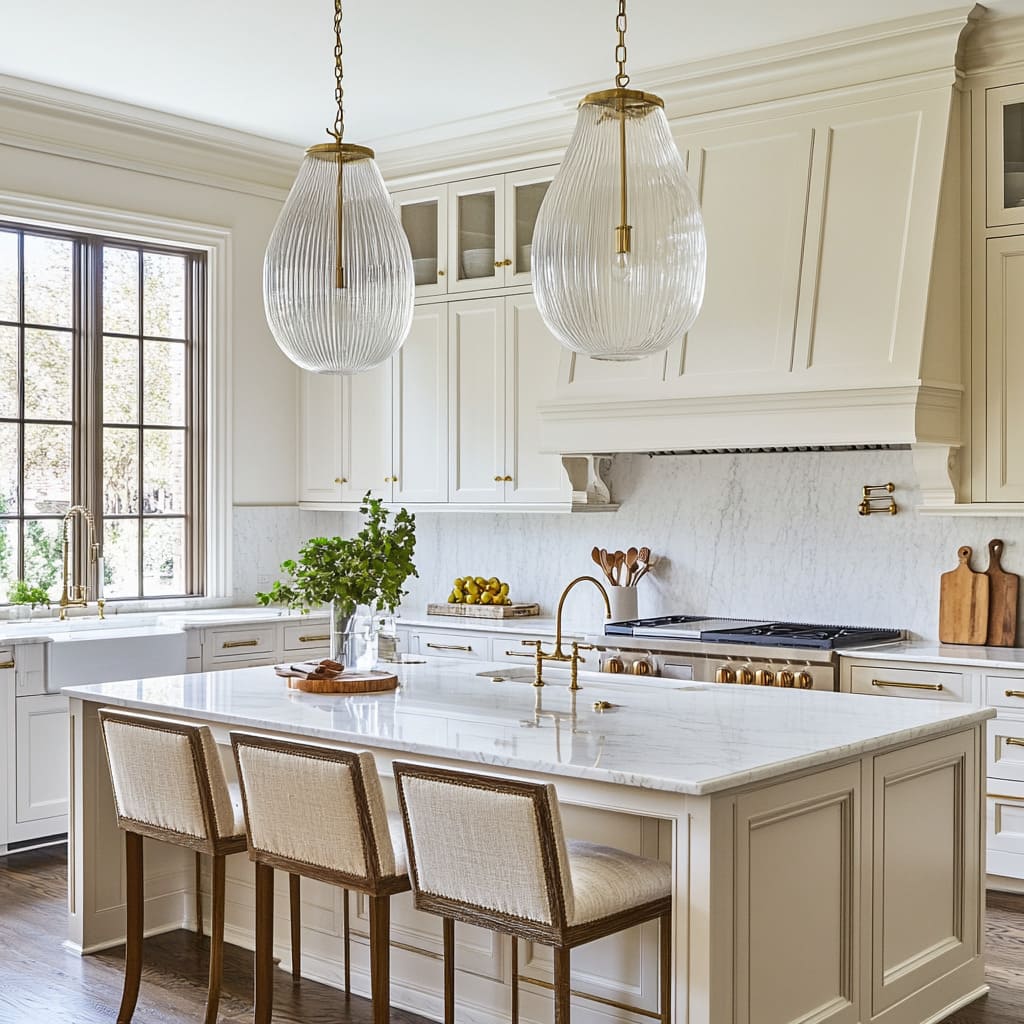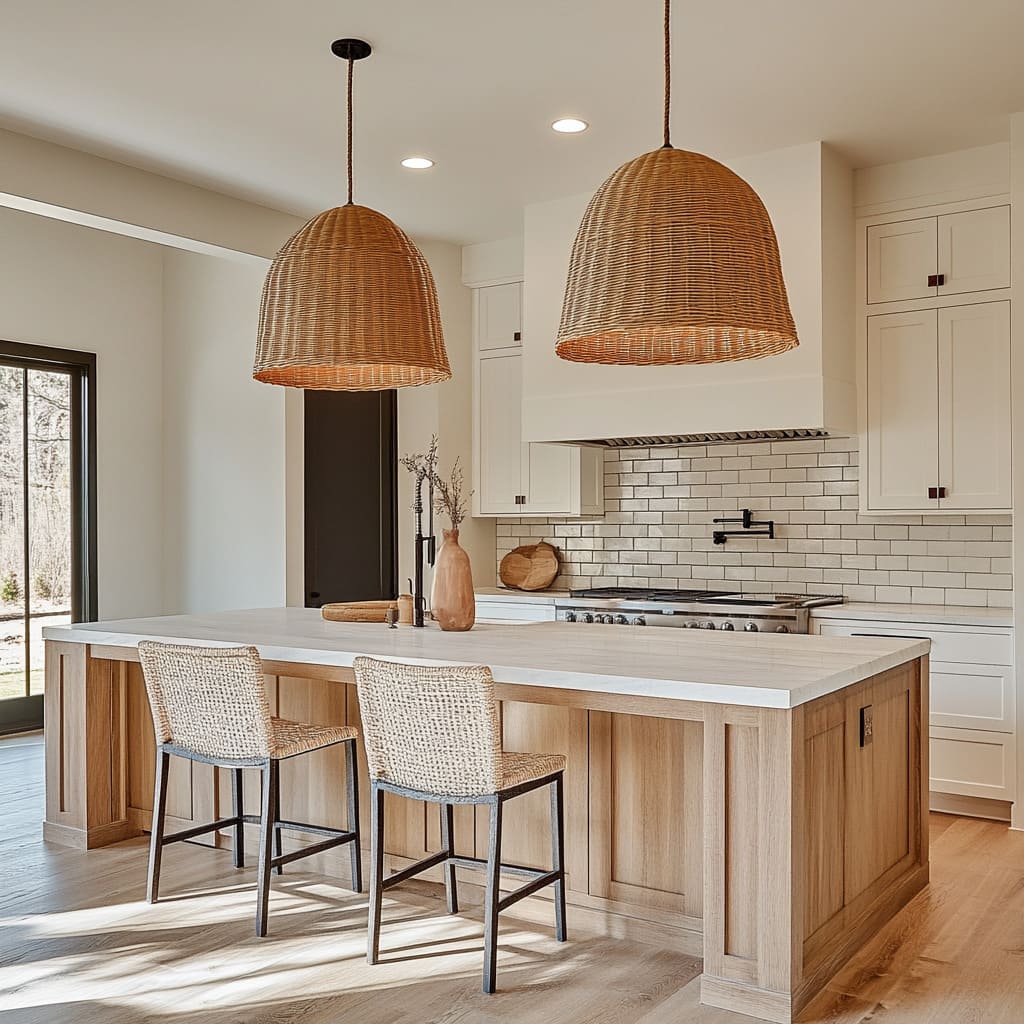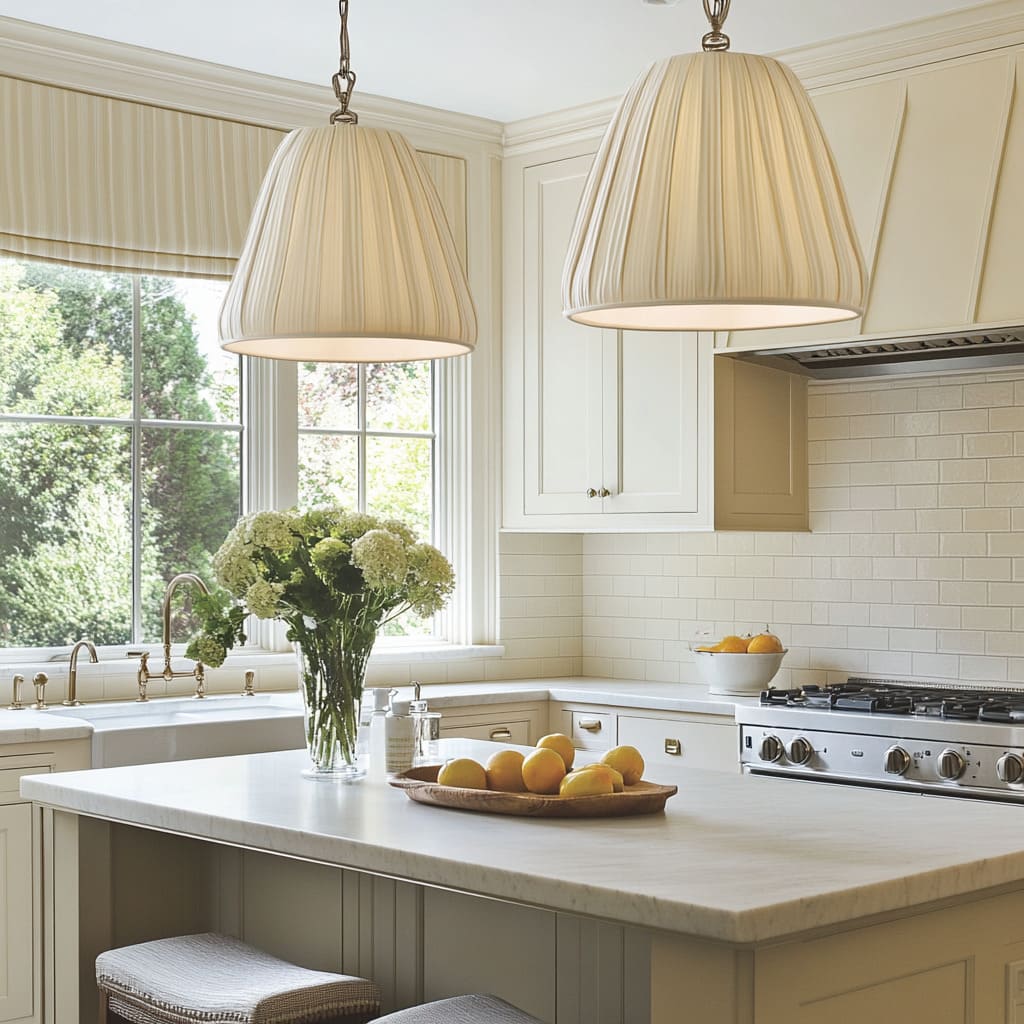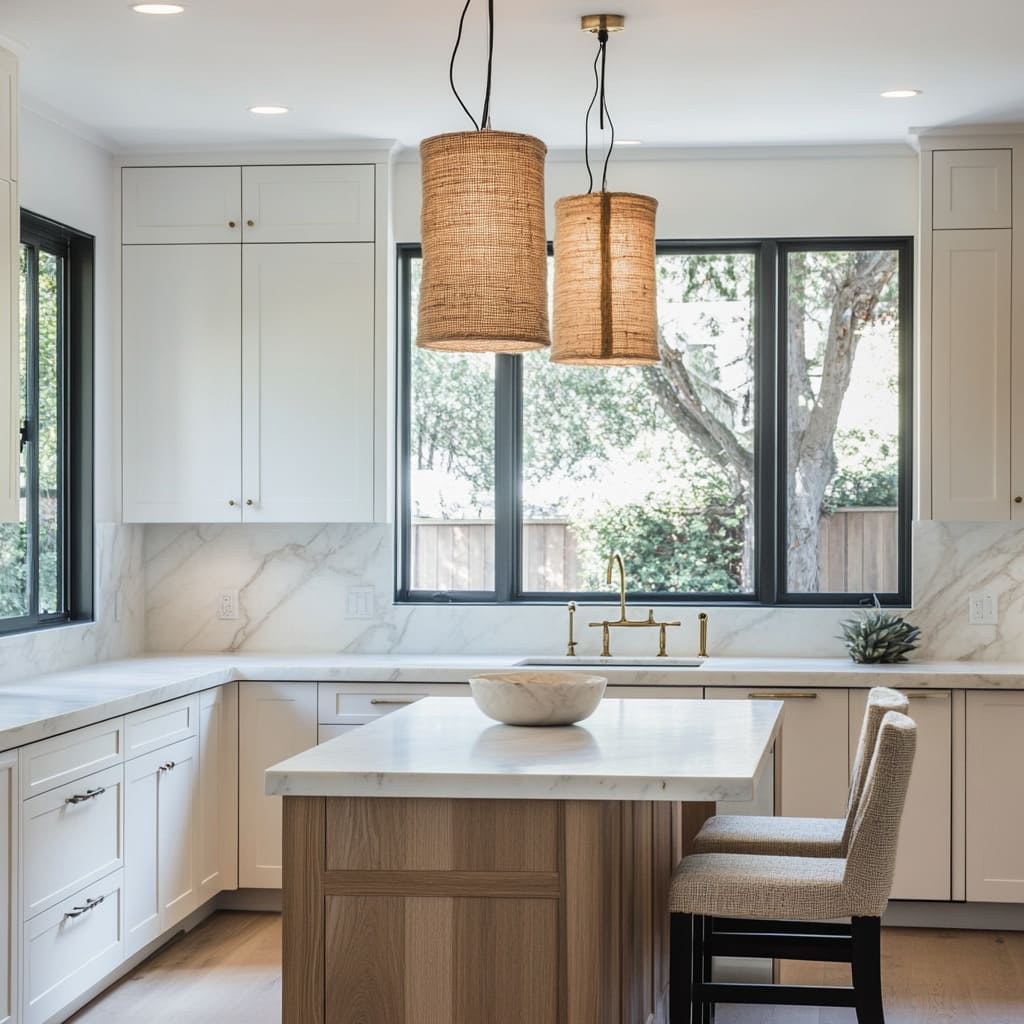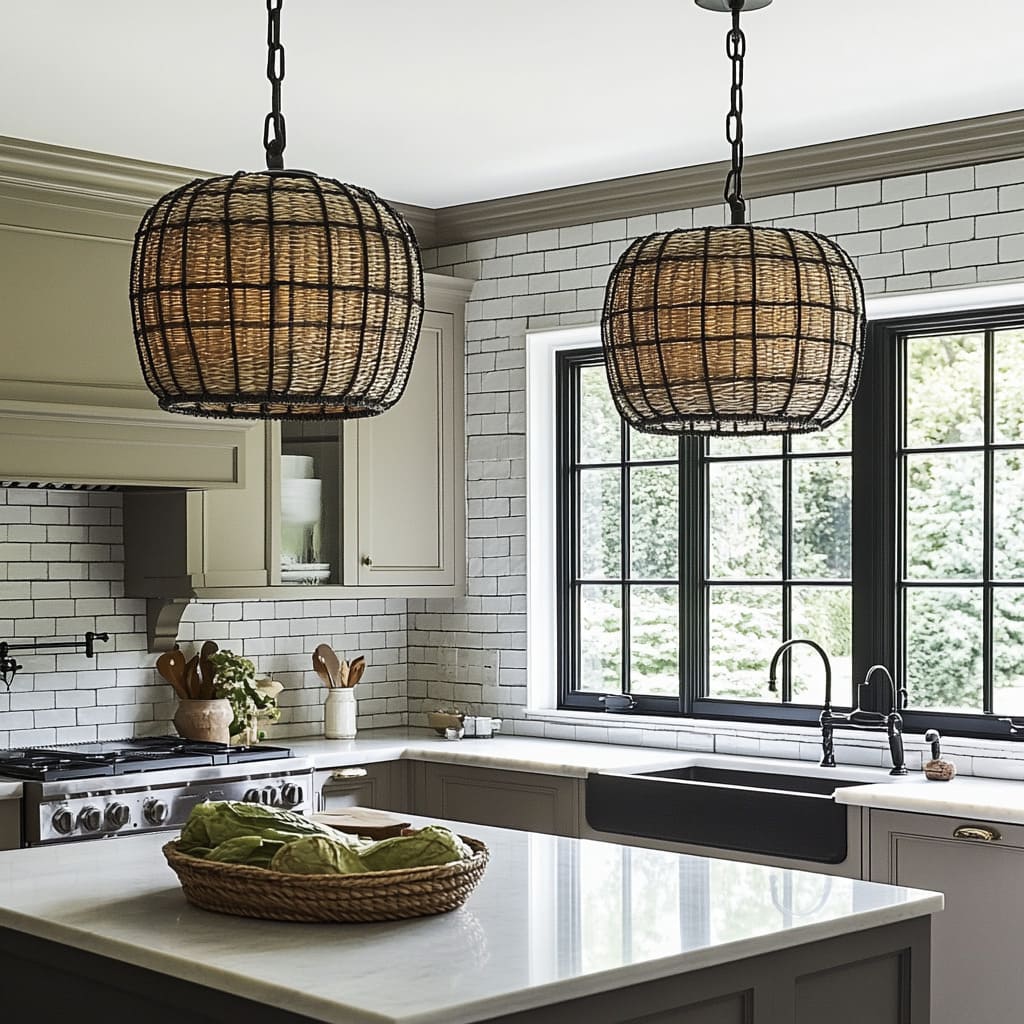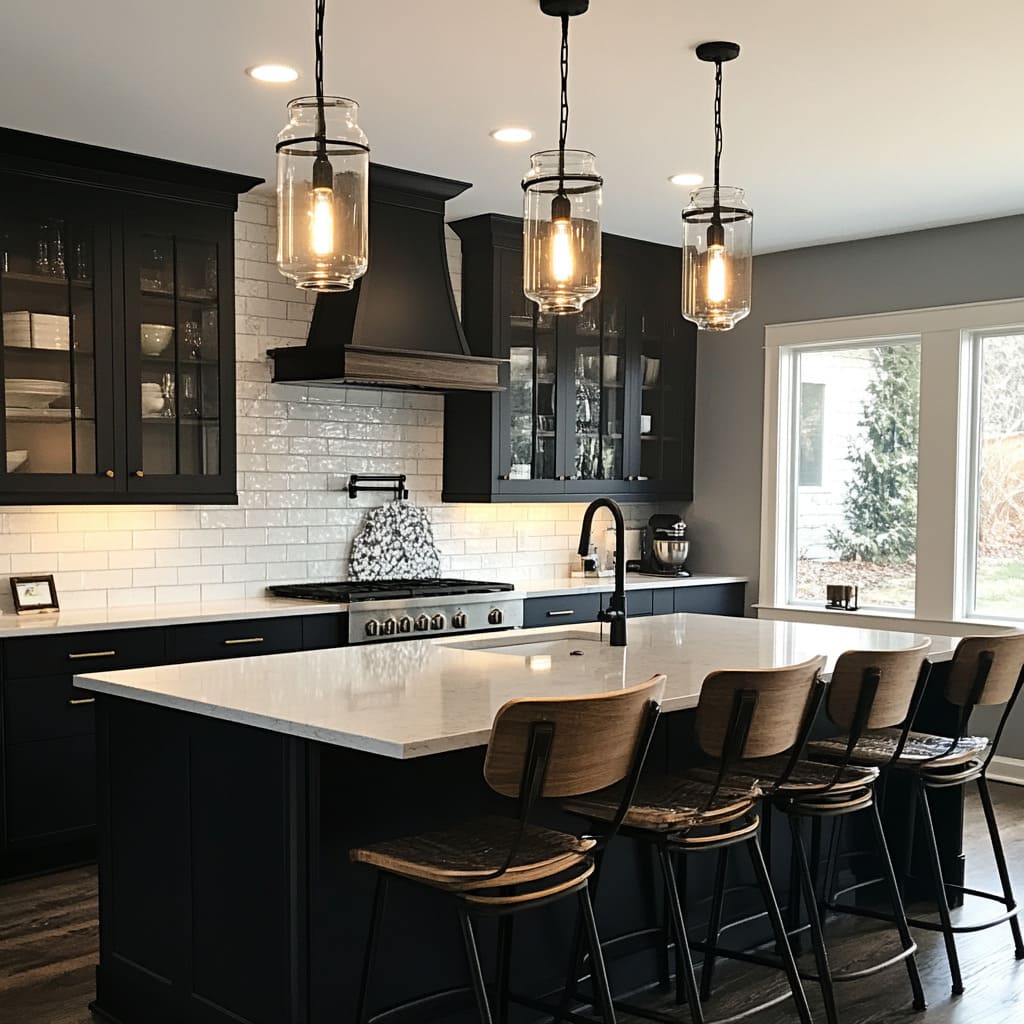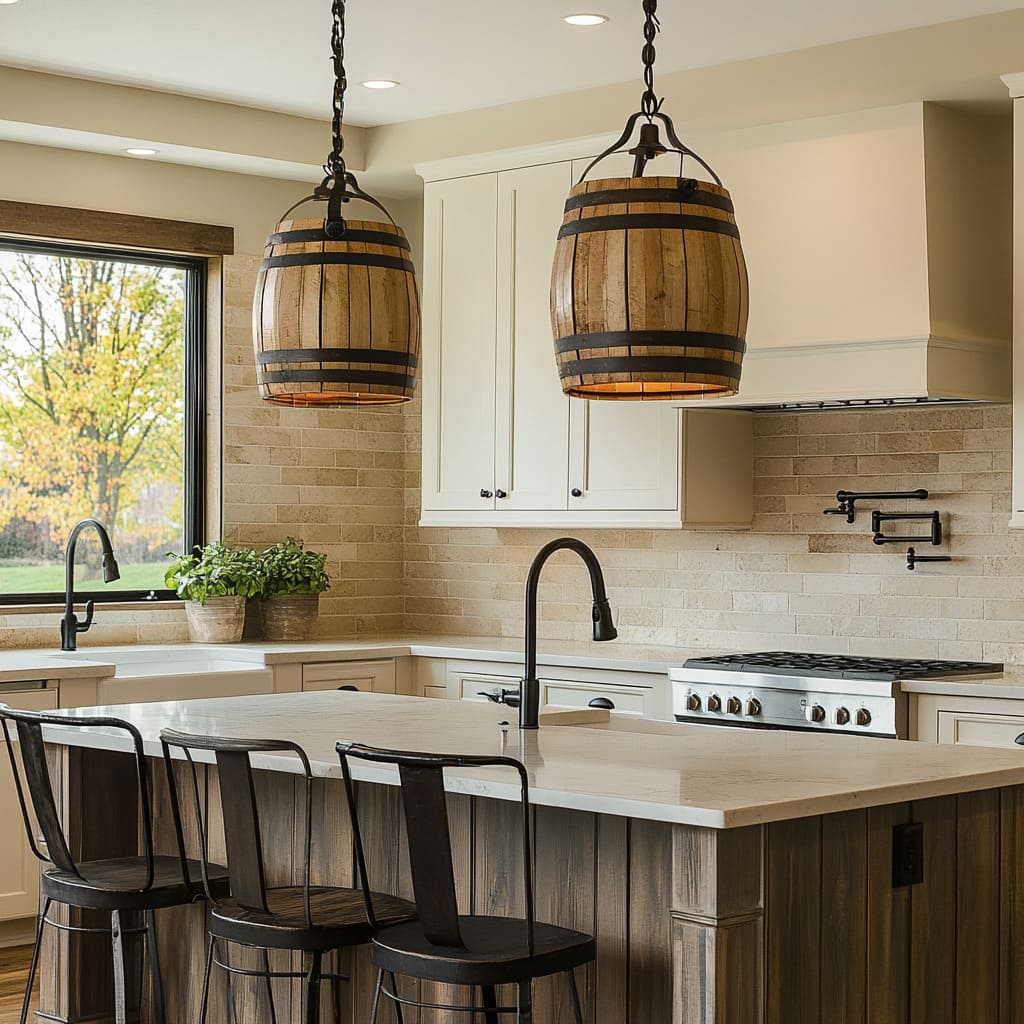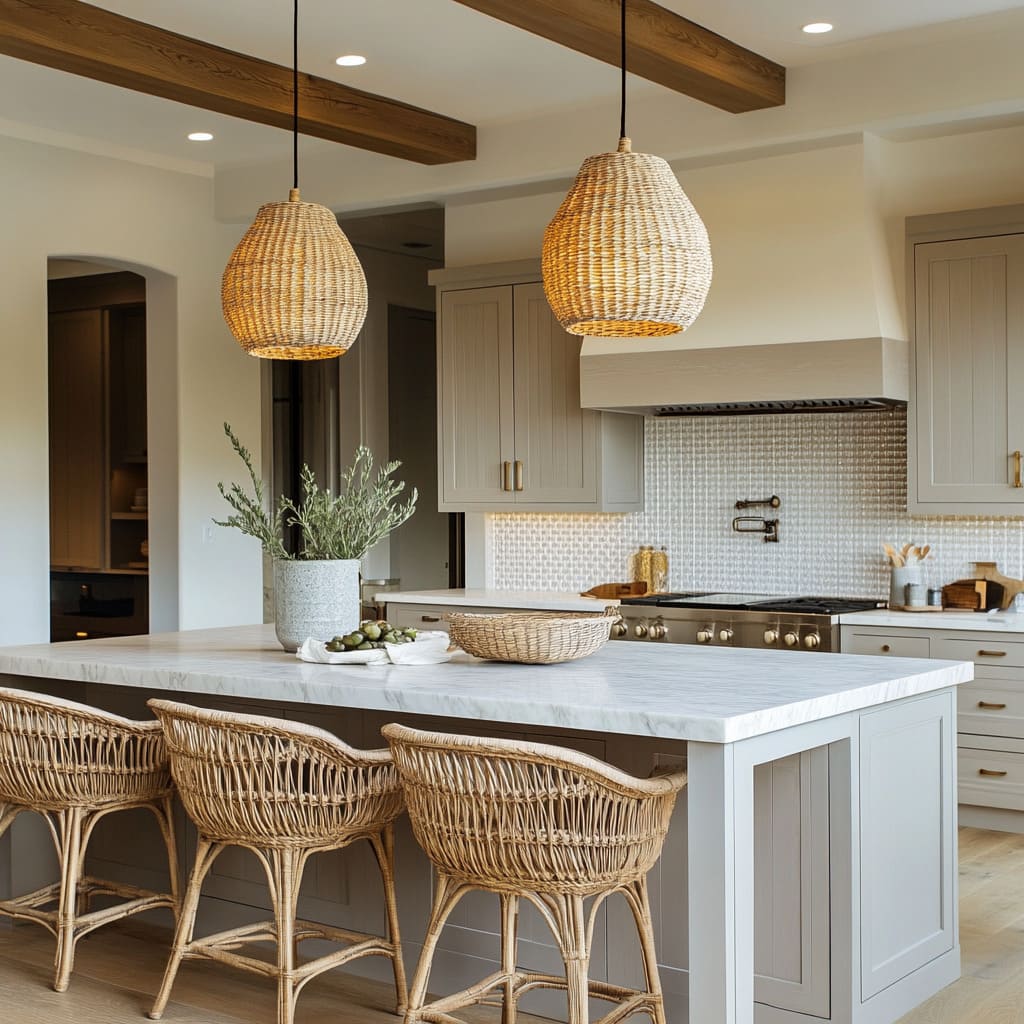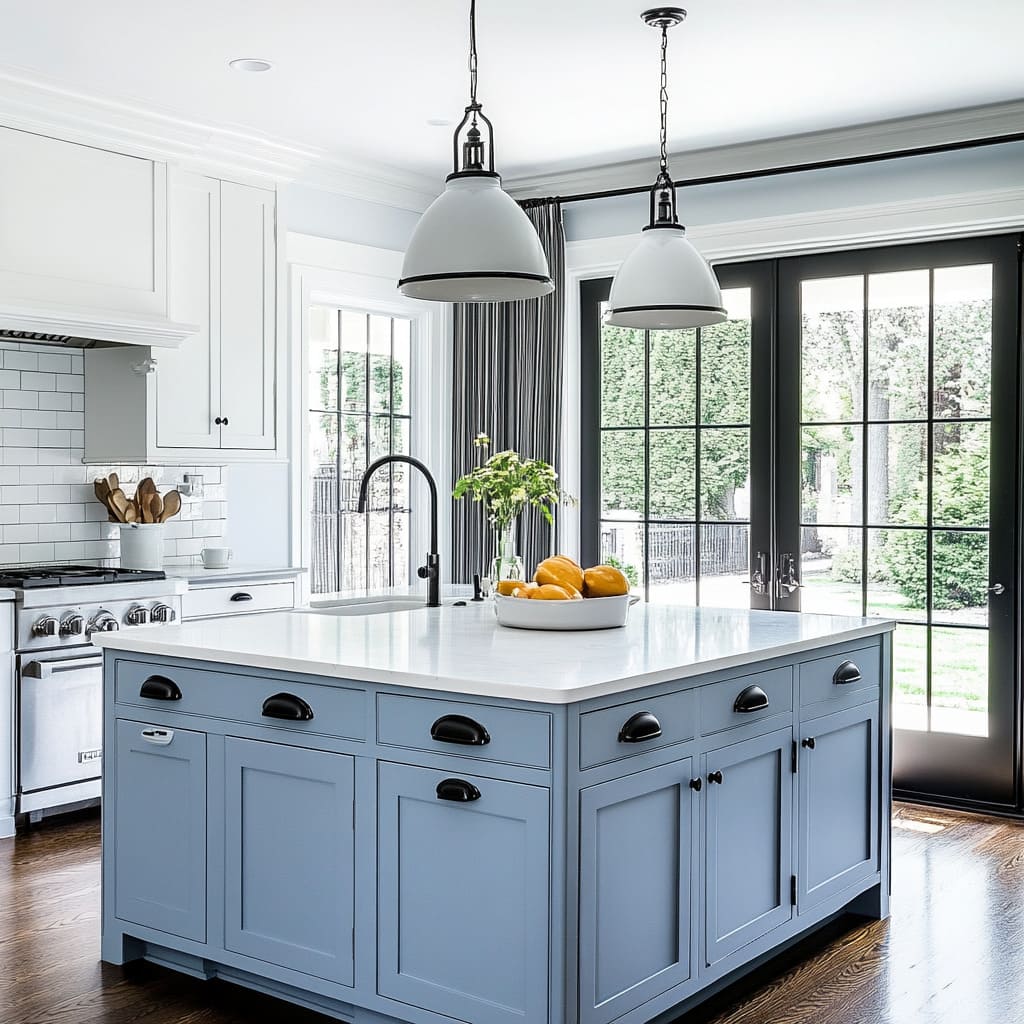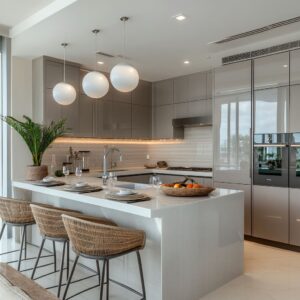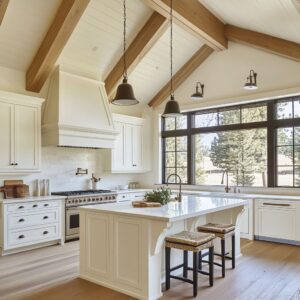Lighting in a modern farmhouse kitchen does a lot more than brighten countertops. It can shape the mood, define the island’s role, and bring together all the materials used throughout the space.
From handwoven rattan pendants that throw delicate shadows to oversized linen lanterns with strong geometry, these fixtures often play quietly but meaningfully. In kitchens across different regions—from breezy coastal layouts to compact gabled setups—thoughtful lighting choices are being used to echo textures, repeat shapes, and respond to natural light in subtle ways.
This article looks deep into modern farmhouse kitchen island lighting ideas, pulling apart what makes these designs click—not just at first glance but on closer look. You’ll see how fabric, scale, color tones, and even the way cords hang all contribute to the mood of a kitchen.
It’s not about flash. It’s about thoughtful contrast, layering, and visual rhythm.
If you’re styling a kitchen that blends comfort with clean lines, or warmth with simplicity, this breakdown will help you notice what usually gets missed.
Texture and Organic Materials
Woven and Rattan Pendants
- Many kitchens feature lights made from natural fibers such as rattan, wicker, or other hand-braided materials.
- These woven textures diffuse light in gentle, irregular patterns, softening the overall brightness. Close observation often shows how these pendants create quiet interplay with stools, seat upholstery, or subtle décor—tying the ceiling elements to the floor-level furnishings.
- The slight imperfections in the weaving or shaping introduce character that prevents the space from feeling overly rigid. Even in minimalist or refined kitchens, one can see that the handcrafted effect is a strategic design choice to counterbalance polished surfaces.
Fabric and Linen Lanterns
- Certain kitchens embrace fabric or linen pendants that generate a warm glow. The gentle diffusion eliminates harsh shadows, creating a more inviting atmosphere.
- Fabric-wrapped lanterns or drum pendants can be large in diameter yet not visually heavy, thanks to their translucent quality. Many times, the linen is framed with trim in black or brown, ensuring a crisp outline and linking the fixture to darker architectural elements like window frames or faucet finishes.
Beaded Wood and Clay/Plaster Finishes
- Some lights are composed of wooden beads or clay-like materials. These fixtures contribute an almost sculptural effect, becoming a functional statement piece.
- Subtle irregularities, whether in bead spacing or chalky plaster texture, are essential. Light bounces off these surfaces in a way that enlivens the pendants when viewed from different angles.
In farmhouse design, contrasts often revolve around warm/cool or rough/smooth. The textural pendants align with that concept.
For instance, hammered metal pendants reflect uneven glimmers, while woven fiber lights cast patterned shadows. Each approach offers a distinctive way of adding complexity to an otherwise clean-lined space.
Scale and Height Placement
Large Forms for Strong Presence
- Oversized pendants ensure the lighting competes confidently with tall ceilings, extensive cabinetry, and grand windows. When pendant diameters nearly match the island width in the user’s vantage point, the fixtures become focal anchors.
- In narrower or more compact kitchens, lights that are slightly bigger than expected compensate for a smaller footprint, preventing the space from appearing under-lit or visually sparse.
Hanging Height Adjustments
- Some examples show modern farmhouse pendants deliberately placed a bit higher to highlight coffered ceilings or structural beams, while others drop them lower to define the island area more intimately.
- Subtle misalignment may appear unintentional, but can actually cater to seating arrangements rather than centering strictly on the island’s dimensions. This approach prioritizes everyday usage (like where people sit or work) over a rigid grid layout.
Scaling the pendants is rarely about raw diameter alone—visual weight, transparency, and the height at which they hang all matter. An open glass or woven shade can allow for larger proportions without overpowering.
Meanwhile, more opaque pendants often require careful height placement to avoid blocking sightlines.
Integration of Metal Finishes
Brass, Black Iron, and Mixed Metals
- Many farmhosue kitchen designs pair lighting hardware with faucets, cabinet pulls, or pot fillers. Brass is especially prominent, ranging from brushed to aged or hammered.
- Black metal or iron provides contrast in kitchens that favor lighter cabinetry, bridging window frames, door hardware, or stool legs with the lighting.
- In some designs, the fixture’s chain or rod acts like an accent piece, carefully echoing other verticals in the space or matching the tone of the range hood.
Metal finishes go beyond mere color coordination. The reflectivity of a hammered surface, the softness of brushed brass, and the matte look of iron each change how light travels in the room.
Brass can bounce subtle yellowish warmth onto nearby surfaces, while black frames a fixture’s shape crisply. Paying attention to these reflections or how each metal “ages” over time can add a layer of depth.
Conversation Between Lighting and Island
Color Matching and Contrast
- Kitchens use bold island paint (blue, sage, and other colors) with lighting that ties into black or brass details, unifying the color scheme.
- Others opt for wood tones in the island that resonate with natural-fiber pendants. This synergy helps the island function as a bridging element: the wood base meets the woven fixture up above.
Repeating Shapes and Materials
- Round pendants often appear above islands with curved stools or circular décor items (round bread loaf, round fruit bowl).
- Square or rectangular lanterns respond to linear islands or coffered ceilings. Observing these repeated shapes reveals that many designers pick up on geometric cues and replicate them at multiple levels.
The island is typically the heart of the kitchen, and lighting can accentuate its importance. Repetitions in shape (teardrop fixtures over curved stools, drum shades echoed in round décor) create a cohesive visual pattern.
Even the thickness or finish of the island countertop can be chosen to either reflect light upward or absorb glare.
Subtle Cues in Cord and Chain Details
Free-Hanging Cords vs. Structured Rods
- In some designs, pendant cords deliberately hang loose or slightly off-center, injecting a hand-touched vibe that contrasts a highly streamlined environment.
- Elsewhere, thin black rods or polished brass stems keep the fixture lines crisp and intentional, focusing the eye on the pendant shade rather than the suspension mechanism.
Chains and Leather Straps
- Brass or iron chains with decorative twists introduce a historic or industrial nod, aligning with the farmhouse aesthetic.
- Leather strap attachments are a nuanced choice that conveys warmth and craftsmanship. Though less common, they add an appealing layered look between fixture and ceiling.
Cords, rods, and chains are not just functional; they can be a subtle method of blending historical references with contemporary lines. In certain kitchens, the chain detailing echoes other small metal flourishes (hood rivets, bracketry on open shelves), illustrating the designer’s step-by-step approach to unify the space at a micro level.
Interaction with Natural Light
Filtering Daylight vs Evening Ambiance
- Modern farmhouse kitchens often have large windows or doors, meaning natural light already floods the space. The pendant selection sometimes takes advantage of this by allowing partial transparency (glass pendants, open weaves) to complement daytime brightness.
- By night, these same kitchen island pendants define a more intimate aura. Designers often choose diffused or textured shades (linen, rattan) to avoid stark brightness after sundown.
Aligning Windows and Lighting
- Pendants are frequently placed to reinforce a window’s central axis. Although not always symmetrical, the alignment resonates with how people use and move around the kitchen.
- In spaces where windows wrap around corners, pendants help unify the overhead plane with the bright views, framing rather than blocking them.
One overlooked aspect is how the pendant’s material reacts to daylight when the fixture is off. For example, hammered brass can still glow gently in sunlight, and woven fiber pendants reveal their pattern more clearly.
Designing with both day and night lighting in mind is crucial for a balanced farmhouse kitchen.
Understated Functional Details
Bulb Selection and Glow
- Edison-style bulbs add a nostalgic nod. In clear glass pendants, the glowing filament can be a design statement by itself.
- In diffused fixtures (fabric or paper-like pendants), the bulb is hidden or softened, producing a uniform glow that relaxes the overall environment.
Concealed Shelf Lighting and Ambient Layers
- Some kitchen include hidden lighting under floating shelves or inside glass cabinets. Although not part of the pendant itself, this layered strategy works with the pendants to eliminate flat overhead brightness.
- The best farmhouse designs often avoid using pendants as the sole light source; they incorporate recessed cans, sconces, and under-cabinet fixtures to craft a more balanced feel.
The interplay between the pendant bulb type and ambient lighting is key to a comfortable kitchen. An exposed filament sets a warm, vintage tone but might require dimmers to prevent glare.
A concealed or frosted bulb ensures more uniform illumination but reduces that decorative filament effect. The final choice depends on whether the designer wants the fixture to be bold or subdued after dark.
Recurrent Patternwork and Visual Echoes
Subtle Replication of Shapes
- Teardrop pendants above curved counters or stools reinforce fluid lines. Globe pendants above round décor or shaped food items.
- Boxy lanterns repeated in ceiling beams or tile patterns.
Material Pairings
- Wood-based island? Often matched with a woven or wood-accented fixture.
- Metal range hood or faucet? Typically echoed in pendant hardware, chain, or rod details.
- When different metals or finishes appear, they’re typically repeated at least once or twice so that the look appears intentional, not random.
The highest-level design trick in these kitchens is how repeating shapes and finishes avoid feeling forced. There’s a consistent interplay: the same geometry might be found in multiple areas (backsplash tile, pendant silhouette, stool form).
Paying attention to these connections reveals that every choice is reinforcing another element, creating a cohesive yet layered environment.
Practical Tips for Modern Farmhouse Lighting Selection
- Scale Wisely. Measure island length and ceiling height carefully. Go larger if the room is expansive, but ensure transparency or a soft material if using oversized fixtures in a smaller space.
- Coordinate Metal Finishes Thoughtfully. Exact color matching is not always necessary. Instead, repeat each finish at least once to create balanced accents (e.g., brass faucet and brass pendant caps).
- Consider Bulb Intensity and Color Temperature. Warmer bulbs (2700K–3000K) preserve the cozy farmhouse feel. Dimmable options allow mood adjustments from daytime prep to evening gatherings.
- Think Beyond a Single Focal Point. Mix in under-shelf or sconce lighting to layer illumination. Pendants should be a highlight, not the sole brightness in the room.
- Play with Materials that Reflect or Absorb Light. Hammered metals reflect mesmerizing shards of light. Woven fibers create dappled patterns. Smooth linen or paper yields an even glow.
- Align with the Island’s Use Patterns. Center pendants over seating or primary prep zones if you want to emphasize functionality. Slight offsets can be more comfortable if the seating arrangement calls for it.
- Observe Day vs. Night Appearances. During the day, glass or woven pendants can look different with sunlight streaming through. Evaluate your chosen fixture under both daylight and artificial lighting to ensure a cohesive effect.
Conclusion
Modern farmhouse island lighting is about more than picking a trendy shade or finish. It involves weaving together form, material, and placement so that each fixture both enriches the island’s centrality and coordinates with the overall environment.
By analyzing details such as weave irregularities, cord alignments, reflective surfaces, and subtle shape echoes, one can see the level of intention behind each design. The most successful spaces show that lighting can be both artistic and functional—unifying the kitchen’s focal point (the island) with every other element in the space.
